When Social Media Goes Wrong For Businesses
by Leanne Mordue on 11-Feb-2017 11:45:00

Social media is a strong lead generation tool for B2B businesses, but is wide open to misuse. Achieving the right balance of content, activity and responsiveness is a recipe for building trust and reaching out to new prospects. A wrong-footed approach to social media can have exactly the opposite effect. Here we examine seven common social media mistakes and why you should avoid them.
1) Not Making A Long Term Commitment
Achieving results on social media requires a consistent, long-term approach. A large number of business social media accounts exhibit a flurry of activity for the first couple of months, after which time it looks like a ghost town. This creates a worse impression than not having a social media account at all. Don’t feel you have to do everything at once. Drip feed content and posts onto social media at a steady rate. Committing just a few minutes every day to social media marketing will make all the difference.
2) Excessive Automation
Automation platforms like Mailchimp are fantastic time-saving tools, allowing you to schedule important posts on multiple social platforms. However, automation cannot take the place of customer interaction. It is important to log on regularly yourself and engage with your followers. You should also make sure that you keep control of the scheduling process and not assign this to an app, as this could result in you publishing too many posts successively, which will affect your Facebook Edgerank.
Also, if posting to multiple platforms, customise your posts to suit the requirements of each one. Don’t just send the same post to Facebook, Twitter and LinkedIn. Followers you are linked to on more than one platform will consider this lazy and impersonal. Also, Twitter has different rules and etiquette to Facebook and LinkedIn. Make sure your posts are tailored to both the platform and the target audience.
3) Branding Faux Pas
Be careful what messages you associate with your brand. Making a social media meme – content that combines an image with a quotation or message – is child’s play, but it is so easy to get it wrong. Make sure your brand messaging is consistent and double check it for expressions that may be misunderstood or misinterpreted out of context. It is also not advisable to use uplifting quotes by famous people in support of your memes, unless they have directly endorsed you. It risks coming across as arrogant or presumptuous. For instance, would Martin Luther King really have supported your IT services business? Just saying…
4) Too Many Posts
There is only so much content a user will want to see from a single account. There is no hard and fast rule about how often you should post, but as a rule of thumb this shouldn’t be more than one to five times a day on Facebook or LinkedIn, or 10 to 15 times on Twitter. Otherwise people may get tired of seeing your name on social media and you may even get penalised for spam by the platform. Be careful to include a variety of content in your posts and keep obviously self-promotional material to a minimum.
5) Irrelevant Content
Some business profiles show a regrettable dependency on posting ‘light’ content. This can include memes, ‘humorous’ images, pictures of animals and links to third-party content. These may occasionally be appropriate, but bear in mind your target audience and what they might like to see. Social media content should be targeted and relevant at all times. Avoid the temptation to post irrelevant content simply to keep up your posting frequency. If you genuinely don’t have anything to say at that time, leave it till you do.
6) Unresponsive To Messages
Social media is not primarily a free sales channel. It’s a relationship building device, so it is really important to respond to your customer’s messages. If you’re a small business it is perfectly acceptable to leave 24 hours between responses, but make sure you reply truthfully and constructively to every message and comment. Responding empathetically and promptly to your potential customers avoids the risk of alienating them and may even win people over. Polite public responses to complaints and criticism build a reputation for honesty and good service.
7) Too Many Platforms
Don’t spread yourself too thinly by trying to maintain a presence on too many social media platforms. Choose a couple of main ones that are important to your customers and devote yourself to them. Of these, one will normally become your ‘master platform’, but make sure you don’t ignore the others. If one of your social media platforms starts to look unloved, consider whether it is genuinely necessary. We recommend you start with a presence on Facebook and LinkedIn. You can then expand into Twitter, YouTube and potentially Instagram if it suits your business model.
Here are some other great articles we've posted about social media:
- 6 Easy Marketing Tips to Increase Social Media Engagement
- 5 Tips To Making Social Media Marketing Easy!
- How To Evaluate Your Businesses Social Media In 3 Easy Steps!
Social media is a great marketing tool for business development, but it works best as part of an integrated marketing strategy. To find out how best to use social media for your business, have a chat with one of our marketing specialists at JDR. We can help you put together a bespoke strategy that delivers your goals in terms of new leads, ROI and increased profits.
- Inbound Marketing (SEO, PPC, Social Media, Video) (829)
- Strategy (368)
- Sales & CRM (195)
- Marketing Automation & Email Marketing (191)
- Business Growth (167)
- Website Design (161)
- Hubspot (138)
- Lead Generation (117)
- Google Adwords (99)
- Content Marketing (94)
- Conversion (53)
- Case Studies (47)
- News (47)
- Ecommerce (39)
- Webinars (35)
- SEO (26)
- AI (20)
- Events (19)
- LinkedIn Advertising (17)
- Video (17)
- Video Selling (15)
- Software training (13)
- Niche business marketing (11)
- The Digital Prosperity Podcast (10)
- Facebook Advertising (6)
- HubSpot Case Studies (5)
- January 2026 (7)
- December 2025 (15)
- November 2025 (6)
- October 2025 (17)
- September 2025 (16)
- August 2025 (14)
- July 2025 (14)
- June 2025 (5)
- May 2025 (19)
- April 2025 (15)
- March 2025 (13)
- February 2025 (13)
- January 2025 (8)
- December 2024 (2)
- November 2024 (4)
- October 2024 (21)
- September 2024 (4)
- August 2024 (8)
- July 2024 (14)
- June 2024 (16)
- May 2024 (25)
- April 2024 (15)
- March 2024 (18)
- February 2024 (5)
- January 2024 (10)
- December 2023 (6)
- November 2023 (10)
- October 2023 (13)
- September 2023 (12)
- August 2023 (14)
- July 2023 (13)
- June 2023 (14)
- May 2023 (15)
- April 2023 (13)
- March 2023 (14)
- February 2023 (13)
- January 2023 (15)
- December 2022 (13)
- November 2022 (6)
- October 2022 (8)
- September 2022 (22)
- August 2022 (15)
- July 2022 (13)
- June 2022 (16)
- May 2022 (14)
- April 2022 (16)
- March 2022 (17)
- February 2022 (11)
- January 2022 (8)
- December 2021 (6)
- November 2021 (7)
- October 2021 (11)
- September 2021 (10)
- August 2021 (7)
- July 2021 (7)
- June 2021 (4)
- May 2021 (4)
- April 2021 (1)
- March 2021 (3)
- February 2021 (5)
- January 2021 (4)
- December 2020 (7)
- November 2020 (6)
- October 2020 (5)
- September 2020 (9)
- August 2020 (18)
- July 2020 (17)
- June 2020 (17)
- May 2020 (10)
- April 2020 (21)
- March 2020 (24)
- February 2020 (21)
- January 2020 (12)
- December 2019 (23)
- November 2019 (12)
- October 2019 (14)
- September 2019 (16)
- August 2019 (15)
- July 2019 (13)
- June 2019 (6)
- May 2019 (8)
- April 2019 (4)
- March 2019 (2)
- February 2019 (2)
- January 2019 (2)
- December 2018 (3)
- November 2018 (24)
- September 2018 (11)
- August 2018 (9)
- June 2018 (3)
- May 2018 (6)
- April 2018 (14)
- March 2018 (12)
- February 2018 (16)
- January 2018 (15)
- December 2017 (15)
- November 2017 (18)
- October 2017 (23)
- September 2017 (19)
- August 2017 (28)
- July 2017 (27)
- June 2017 (25)
- May 2017 (18)
- April 2017 (17)
- March 2017 (16)
- February 2017 (17)
- January 2017 (14)
- December 2016 (21)
- November 2016 (27)
- October 2016 (25)
- September 2016 (16)
- August 2016 (20)
- July 2016 (19)
- June 2016 (14)
- May 2016 (20)
- April 2016 (24)
- March 2016 (22)
- February 2016 (28)
- January 2016 (27)
- December 2015 (28)
- November 2015 (19)
- October 2015 (9)
- September 2015 (12)
- August 2015 (5)
- July 2015 (1)
- June 2015 (10)
- May 2015 (3)
- April 2015 (11)
- March 2015 (14)
- February 2015 (15)
- January 2015 (12)
- December 2014 (2)
- November 2014 (23)
- October 2014 (2)
- September 2014 (2)
- August 2014 (2)
- July 2014 (2)
- June 2014 (7)
- May 2014 (14)
- April 2014 (14)
- March 2014 (7)
- February 2014 (2)
- January 2014 (7)
- December 2013 (9)
- November 2013 (14)
- October 2013 (17)
- September 2013 (3)
- August 2013 (6)
- July 2013 (8)
- June 2013 (4)
- May 2013 (3)
- April 2013 (6)
- March 2013 (6)
- February 2013 (7)
- January 2013 (5)
- December 2012 (3)
- November 2012 (2)
- September 2012 (1)
Subscribe by email
You May Also Like
These Related Blogs

Social Media Slip's and Trips: How Not To Lose Followers
Expectations often lead to disappointments and that's sometimes the case with social media when we go to sign into our accounts. Watching your followe …

Social Media 101 for Business: How to Use Social Media Marketing for B2B Businesses
The phrase “social media” lends itself to a casual tone, and that can be misleading to business owners who are looking for ways to engage other compan …

4 Social Media Mistakes That Will HARM Your Business
Whether your favourite network is Facebook, Twitter, LinkedIn or Google+, there are some things you should avoid doing if you want to grow your commun …



